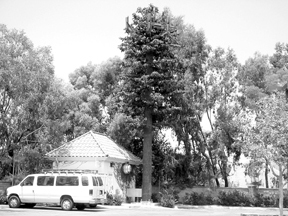Cell phones are as common as e-mail and Palm Pilots, and users want flawless
coverage, but it comes at a price – cell phone towers and antennas may be deemed
an ugly side effect of the necessity to communicate.
Service providers are finding creative ways to camouflage them and lessen their impact.
“Generally we try to use existing structures,” said Richard Enright, director of engineering for Verizon Wireless in New England. “Only if there is nothing (there) do we then build a tower.”
The most commonly used structures are existing cell towers – Verizon’s or another service provider’s tower – or water tanks. Some of the more creative locations for antennas have included church steeples, commercial buildings, farm silos, tall outdoor sculptures, clock towers and highway signs.
“It’s become industry practice over the last eight or nine years to share space,” Enright said. “Towns don’t want us all doing our own thing. Some towns want one tower with everyone on it, and some towns want lots of shorter towers.”
Verizon also installs monopoles, which minimize the aesthetic impact of a lattice tower – they are shorter, slimmer and can be more easily camouflaged with a barrier of trees or some paint. And if necessary, the sleekest of camouflaged towers – what Enright calls “monopines” – are poles covered with rubber bark and plastic leaves, made to look like a palm or evergreen tree, depending on the resident tree population.
“They’re very concerned with the visual impact,” Enright said of towns. “We’ve built silos (to add antennas), painted them brown, added steeples to churches whose steeples had been destroyed. If there is something we can do to lessen the impact, we’ll do that first.”
In South Kingstown, privately owned cell phone towers are only allowed in industrial areas, and in some commercial areas with special use permits and some non-residential areas, like on water tanks and existing towers, according to Vin Murray, director of planning.
“Our ordinance is somewhat restrictive – and proudly so – on new towers,” he said. “Our preference is for co-location versus new structures.”
There are a handful of towers, water tanks and monopoles in South Kingstown, Murray said, and the service coverage in the area is mostly sufficient throughout town.
“There are some areas in town where the coverage is not optimal, but that’s OK with me,” he said. “The coverage is fairly reasonable within town with the existing structures.”
South Kingstown’s town ordinance on the placement of towers also prohibits them in historic overlay districts. Any tower or pole higher than 150 feet requires a special use permit.
“Generally people want them, but they don’t want them in specific locations,” Enright said. “Most people say they have a cell phone and need coverage, but not here in this spot. Their objection is based on the visual impact, and a much smaller amount of people are concerned about the health impacts.”
Cell phone towers aren’t as visually offensive now as they used to be, said David DeQuattro, executive vice president and architect for The Robinson Green Beretta Corp. in Providence. And satellite technology may some day make them obsolete, he said.
“How do you make something that’s 300 or 400 feet high” visually pleasing, he said. “They’re not as large (now) as the older ones, and they’re not that bad-looking; I just wish they had them in better spots.”
Like Enright, DeQuattro said from an architectural standpoint, utilizing buildings and water tanks could help hide the larger towers and antennas, as well as false architectural elements.
“When you’re designing a building, you need to configure where the satellite,” and other telecommunications systems will be installed, he said. Some recess the systems into the building, and others go for the faux approach.
“If something has to be on the building, we could do something like two chimneys so it’s symmetrical” – one for the real chimney and another for the telecommunications.
So what’s the future for cell phone towers? Enright said more of them will come as people continue to purchase cell phones and demand upgraded service. Enright envisions smaller wooden poles in corners of residential neighborhoods and flat antennas will replace the larger metal versions.
“A lot of these will be much less visually obtrusive,” he said. “The market demand (for improvement) is certainly there.”












